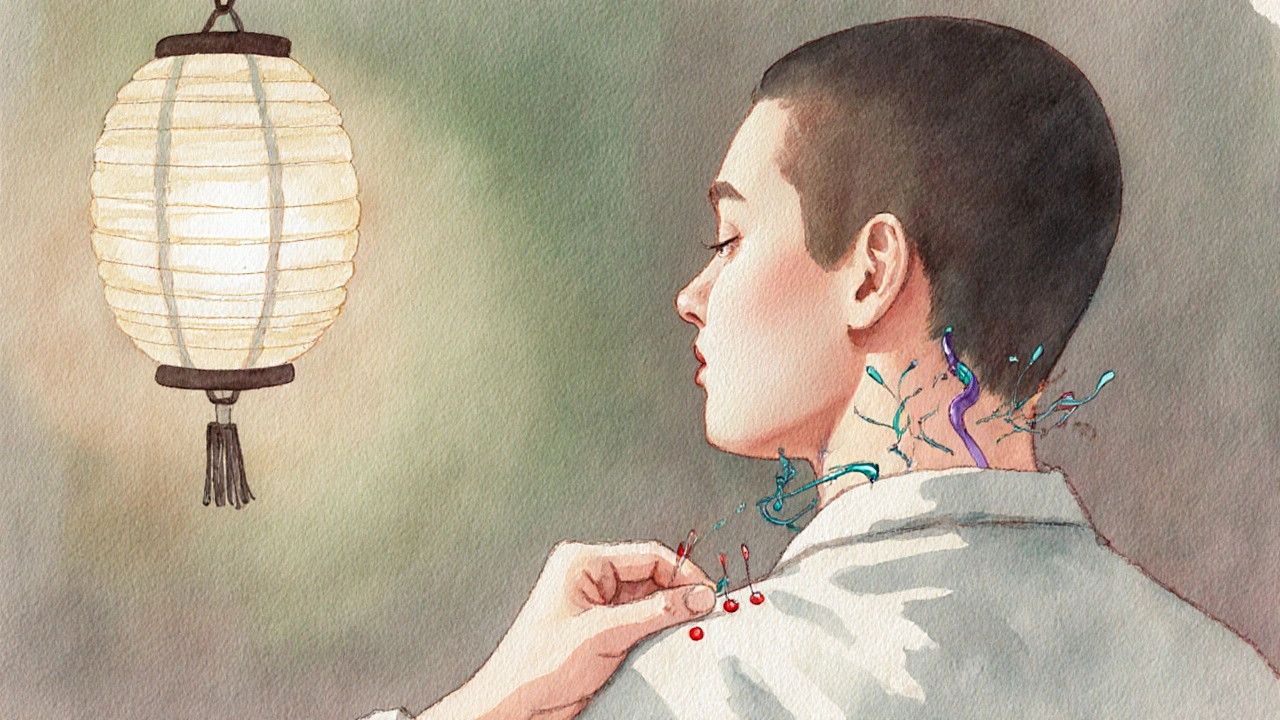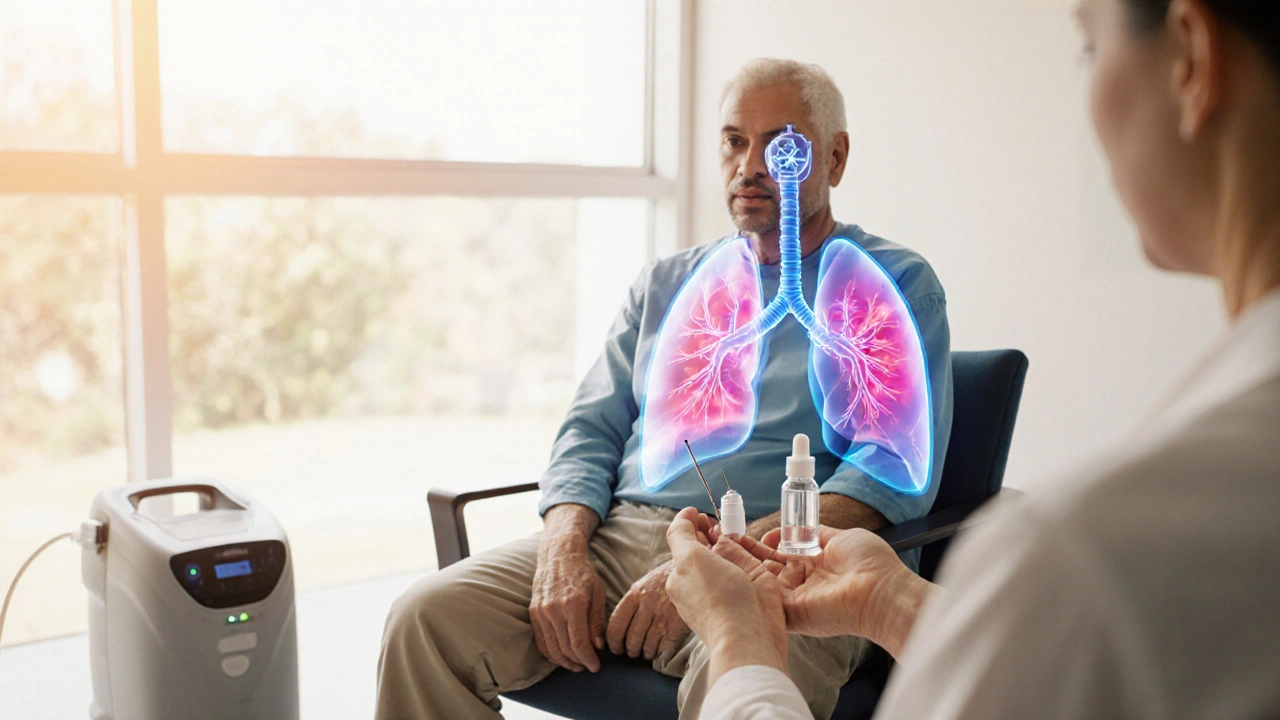IPF Symptom Relief Calculator
Symptom Relief Estimator
This calculator estimates potential improvements in breathlessness and cough for IPF patients considering acupuncture or massage therapies.
Estimated Symptom Relief
Living with idiopathic pulmonary fibrosis (IPF) means coping with persistent shortness of breath, chronic cough, and a steady decline in lung function. While medication and pulmonary rehabilitation are the mainstays of treatment, many patients search for supportive options that can ease symptoms and improve quality of life. Acupuncture for IPF and therapeutic massage are two complementary approaches that have gathered attention in recent years. This guide explains what each therapy does, the science behind them, safety considerations, and practical tips for adding them to an IPF care plan.
Quick Takeaways
- Acupuncture may reduce dyspnea and cough by modulating inflammation and stimulating the nervous system.
- Massage improves chest wall flexibility, reduces muscle tension, and can boost circulation.
- Both therapies are generally safe for IPF when performed by trained practitioners who understand the disease’s limitations.
- Evidence is growing but still limited; they should complement, not replace, standard medical care.
- Start with a qualified practitioner, discuss with your pulmonologist, and track symptom changes regularly.
What Is Idiopathic Pulmonary Fibrosis?
Idiopathic Pulmonary Fibrosis is a chronic, progressive lung disease characterized by thickening and stiffening of the alveolar walls due to scar tissue formation. The cause is unknown (hence "idiopathic"), and the disease typically presents in people over 60. Common symptoms include:
- Shortness of breath that worsens with activity
- Persistent dry cough
- Fatigue and reduced exercise tolerance
- Oxygen desaturation during exertion
Standard care focuses on antifibrotic medications (e.g., nintedanib, pirfenidone), supplemental oxygen, and pulmonary rehabilitation. However, these interventions rarely address the uncomfortable side‑effects such as chest tightness and muscle fatigue, which is where complementary therapies can play a role.
How Acupuncture May Benefit IPF
Acupuncture is a key component of Traditional Chinese Medicine that involves inserting fine needles at specific body points to balance the flow of qi (energy) and stimulate physiological responses.
Three mechanisms are most relevant to IPF patients:
- Neuro‑modulation: Needle stimulation triggers the release of endogenous opioids and serotonin, which can blunt the brain’s perception of breathlessness.
- Anti‑inflammatory effects: Research on animal models shows acupuncture can lower cytokines such as IL‑6 and TNF‑α, both implicated in lung fibrosis progression.
- Improved autonomic balance: By enhancing parasympathetic activity, acupuncture may reduce heart rate variability associated with dyspnea episodes.
Clinical evidence is still emerging. A 2022 pilot trial in Japan enrolled 30 IPF patients who received weekly acupuncture for eight weeks. The treatment group reported a 15% reduction in Modified Medical Research Council (mMRC) dyspnea scores and a modest increase in six‑minute walk distance, while lung function (forced vital capacity) remained stable. Although the sample size was small, the results suggest a symptom‑relief potential without adverse effects.

How Massage Therapy Can Help
Massage therapy encompasses a range of hands‑on techniques-such as myofascial release, Swedish massage, and lymphatic drainage-designed to manipulate soft tissue.
For people with IPF, massage offers three practical benefits:
- Chest wall mobility: Gentle rib‑cage massage loosens intercostal muscles, making it easier to expand the lungs during breathing exercises.
- Muscle relaxation: Reduced thoracic and upper‑back tension can lower the work of breathing, decreasing oxygen demand.
- Circulatory boost: Improved peripheral circulation helps deliver oxygen to tissues, which can alleviate fatigue.
A 2021 observational study in the United Kingdom followed 45 IPF patients who received bi‑weekly massage for three months. Participants reported a 20% decrease in perceived breathlessness on the visual analogue scale and a notable improvement in sleep quality. No serious adverse events were recorded, though a few patients experienced mild skin reddening at pressure points.
Comparing Acupuncture and Massage
| Aspect | Acupuncture | Massage |
|---|---|---|
| Primary action | Neuro‑modulation & anti‑inflammatory signaling | Soft‑tissue mobilization & circulation enhancement |
| Typical session length | 30-45minutes | 45-60minutes |
| Frequency in studies | 1-2times/week | 1-2times/week |
| Reported symptom relief | Dyspnea ↓ 10‑15%, cough ↓ 5‑10% | Dyspnea ↓ 15‑20%, muscle fatigue ↓ 10‑15% |
| Safety concerns | Bleeding, infection, needling contraindicated over scar tissue | Bruising, discomfort over bony areas, avoid deep pressure on ribs |
Safety, Contra‑indications, and Precautions
Both therapies are low‑risk when performed by certified professionals, but IPF patients have specific considerations:
- Bleeding risk: Some IPF patients take anticoagulants (e.g., warfarin). Acupuncturists should use shallow needling and avoid highly vascular points.
- Oxygen dependence: For patients on home oxygen, therapists must ensure equipment is not disturbed and that the treatment environment is well‑ventilated.
- Rib fragility: Advanced fibrosis can make ribs more prone to fracture. Massage should focus on soft tissues, avoiding deep pressure on the bony thorax.
- Skin integrity: Chronic cough can cause bruising or skin tears; both modalities should use gentle techniques and check skin condition before starting.
Before beginning either therapy, discuss the plan with your pulmonologist. A written note clarifying the patient’s medication list and oxygen needs helps the practitioner tailor the session safely.
Integrating Complementary Therapy with Standard Care
Think of acupuncture and massage as add‑ons-not replacements-for approved IPF treatments. Here’s a simple integration model:
- Baseline assessment: Record mMRC dyspnea score, 6‑minute walk distance, and FVC before starting.
- Therapy schedule: Choose 1‑2 weekly sessions of either acupuncture or massage, based on personal preference and logistics.
- Concurrent rehab: Continue pulmonary rehabilitation exercises; many therapists coordinate breathing drills during massage.
- Monitoring: Re‑evaluate symptom scores every four weeks. If no improvement, consider adjusting frequency or switching modalities.
- Medication check: Ensure ongoing antifibrotic drugs are taken as prescribed; complementarity does not affect drug metabolism.
Patients who reported consistent symptom relief often described a “mind‑body” synergy: the relaxation from massage made them more willing to engage in breathing exercises, while acupuncture’s calming effect reduced anxiety‑driven tachypnea.

Finding a Qualified Practitioner
Not every therapist knows how to work with a fragile lung condition. Use this checklist when searching:
- Certified by a recognized board (e.g., British Acupuncture Council, Register of Massage Therapists).
- Experience with chronic respiratory diseases-ask for references or case examples.
- Willingness to communicate with your healthcare team and document treatment notes.
- Clean, private treatment space with easy access for mobility aids and oxygen equipment.
- Clear policies on session cancellation, especially if symptoms flare up.
Many UK hospitals now have integrative medicine departments that can refer you to vetted practitioners. Alternatively, reputable private clinics in Exeter and surrounding counties often list specialists on their websites.
Practical Tips for a Successful Session
- Wear comfortable, breathable clothing that allows easy access to the upper back and neck.
- Bring your oxygen equipment and ensure the therapist knows how to keep tubing untangled.
- Hydrate before and after treatment; both therapies can stimulate lymphatic flow.
- Keep a symptom diary (dyspnea rating, cough frequency, sleep quality) to track progress.
- Ask for modifications if you feel light‑headed or experience pain-therapy should never be painful.
Summary Checklist for IPF Patients Considering Acupuncture or Massage
- Consult your pulmonologist and get clearance.
- Identify a certified practitioner experienced with respiratory conditions.
- Start with a low‑intensity session; gauge tolerance.
- Document symptom changes weekly.
- Re‑assess after 8-12 weeks; decide whether to continue, adjust frequency, or try the other modality.
Frequently Asked Questions
Can acupuncture replace my IPF medication?
No. Acupuncture is a complementary therapy that may ease breathlessness and cough, but it does not stop scar tissue from forming. Continue antifibrotic drugs and follow your pulmonologist’s regimen.
Is massage safe if I use supplemental oxygen?
Yes, as long as the therapist secures your oxygen tubing and avoids deep pressure over the ribs. Always inform the therapist about your oxygen flow rate.
How often should I receive these therapies?
Most studies used 1‑2 sessions per week for 8-12 weeks. Frequency can be adjusted based on symptom response and personal schedule.
Will insurance cover acupuncture or massage for IPF?
Coverage varies by provider. Some UK private health plans reimburse qualified complementary therapies; NHS coverage is limited to clinical trial settings. Check your policy details.
What side effects should I watch for?
Mild bruising, temporary soreness, or slight dizziness are the most common. If you notice increased coughing, wheezing, or skin irritation, stop the session and contact your doctor.

All Comments
jeff lamore October 5, 2025
I think it’s worth noting that both acupuncture and massage have relatively low risk when done by qualified practitioners, but they should definitely be discussed with your pulmonologist first to make sure there’s no conflict with your medication or oxygen setup.
Kris cree9 October 6, 2025
lol this is just hype lol.
Paula Hines October 7, 2025
When we contemplate the intricate tapestry of human physiology it becomes evident that the breath we draw is not merely a mechanical exchange of gases but a profound dialogue between tissue and spirit and it is within this dialogue that modalities such as acupuncture find their subtle foothold the insertion of fine needles at precise meridian points may invoke endogenous opioids and serotonin which in turn modulate the central perception of dyspnea thereby offering a reprieve to those beleaguered by idiopathic pulmonary fibrosis the anti‑inflammatory cascade triggered by needle stimulation can attenuate cytokines like IL‑6 and TNF‑alpha which are implicated in the fibrotic cascade and while the evidence remains nascent the pilot trials from Japan suggest a modest improvement in six‑minute walk distance and a measurable reduction in mMRC scores this does not imply a cure but rather a complementary avenue that can be integrated into a holistic care plan moreover the autonomic balance restored through parasympathetic activation may alleviate the tachypneic episodes that often accompany anxiety in chronic lung disease thus the patient experiences not just physical but psychological amelioration the safety profile, when administered by certified acupuncturists familiar with pulmonary constraints, is acceptable albeit precautions must be taken regarding anticoagulation and the avoidance of needling over scar tissue the same cautionary principles apply to massage therapy where myofascial release and gentle rib cage manipulation improve chest wall compliance and reduce the work of breathing the lymphatic drainage component can enhance peripheral circulation and mitigate fatigue a British observational study noted a 20% reduction in perceived breathlessness and an uplift in sleep quality reinforcing the notion that tactile therapies can have systemic benefits these benefits, however, are contingent upon skilled practitioners who appreciate the fragility of the ribcage in advanced fibrosis and who can adapt pressure to avoid bruising or discomfort the integration of such complementary therapies should be predicated on a clear communication channel between the patient, the pulmonologist, and the therapist ensuring that oxygen equipment remains unobstructed and that any adverse signs such as increased coughing or skin irritation are promptly addressed in summary acupuncture and massage stand as adjuncts not substitutes for antifibrotic medication and pulmonary rehabilitation they offer a nuanced pathway to symptom relief that respects both the body’s physiological needs and its inherent desire for comfort.
John Babko October 8, 2025
Honestly, the data is compelling, especially when you consider that a 15‑20% reduction in dyspnea can translate into a dramatically better quality of life, and that’s not just a statistic, it’s a lived experience; the fact that both acupuncture and massage are low‑risk, non‑pharmacologic options makes them especially valuable in a healthcare system that often overlooks holistic care, so I’d say give them a try, but always under the guidance of a certified professional who knows the intricacies of IPF!
Stacy McAlpine October 9, 2025
Hey folks, just wanted to point out that these therapies are not a magic bullet but they can be a solid part of a broader wellness plan; make sure you pick someone with proper credentials, keep your doctor in the loop, and track how you feel over time so you can see real benefits.
Roger Perez October 10, 2025
Super curious about how these options could fit into daily life 😊! If you start with a gentle session, you might notice your breathing feels a bit easier, and that can boost confidence for rehab exercises 🚀. Keep a simple diary 📔 and share the results with your care team – collaboration is key! 🌟
michael santoso October 11, 2025
While anecdotal reports abound, one must remain skeptical of overstated claims; the methodological rigor of many cited studies leaves much to be desired, and the placebo effect cannot be dismissed outright, especially in interventions that are heavily dependent on patient expectation.
M2lifestyle Prem nagar October 12, 2025
Try a short session, note any change, and keep it simple.
Karen Ballard October 13, 2025
Great info! 👍😊 Looking forward to hearing more about personal experiences.
Gina Lola October 14, 2025
From a biomechanical standpoint, the modulation of thoracic compliance via myofascial release aligns with current understanding of respiratory mechanics, which is why these adjuncts are gaining traction among interdisciplinary teams.
Leah Hawthorne October 14, 2025
Seems like a balanced approach could work well – integrate the therapies, monitor outcomes, and stay flexible based on what the data shows.
Brian Mavigliano October 15, 2025
If you’re convinced that every needle is a tiny rebellion against conventional medicine, then sure, fight the system-but remember that rebellion without evidence is just chaos dressed as progress.
Emily Torbert October 16, 2025
I hear you, and it’s comforting to know there are gentle options out there that can complement the meds and rehab, especially when they’re done safely and with proper communication.